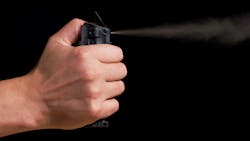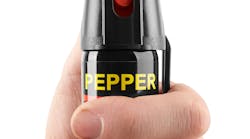The use of aerosol spray irritants by law enforcement dates back to 1965. That year, Mace was on exhibit at the International Association of Chiefs of Police conference held in Miami Beach.[1] One of the topics discussed at the conference was how to change the image of a police officer.[2] Racial tensions and civil unrest had led to a breakdown in the cooperation between the public and law enforcement. Scenes of police officers using their nightsticks against people at peaceful protests had become common. When Mace was unveiled at the conference, police administrators were enthusiastic as it gave officers another force option instead of using their guns or nightstick. It was considered a more humane weapon for law enforcement.[3]
When Mace was invented, it was initially intended as a defensive weapon for women. In 1962, Doris Heil, a high school biology teacher from Pittsburgh, was upset when her friend was attacked while walking down the street. Just talking about fighting crime wasn’t enough, so she had an idea for a defensive weapon for women to ward off attackers. Her idea was an aerosol tear gas device. She took it to a local inventor, Alan Litman, who designed the prototype. It was equipped with a safety catch to prevent it from being fired accidentally.[4]
The basis of his formula was CN gas. However, Litman realized that when CN gas mixes with water, it can form hydrochloric acid, causing a severe burn. The purpose of the device was to incapacitate, not maim. So he experimented and created a combination of CN gas and other chemicals to form phenyl chloromethyl ketone. When the chemical comes into contact with the skin, it reacts with the oils, affecting the nerve endings. The eyes begin to burn, the intake of oxygen is reduced, and the person becomes weak in the knees. The effects last between 15-20 minutes with a range of twenty feet.[6] The device is known initially as TGASI, an acronym for Tear Gas Aerosol Spray Instrument. TGASI was renamed Chemical Mace after Litman was granted a registered trademark on the name.[7]
A new company, General Ordnance Equipment Corporation, headquartered in Pittsburgh, was formed to market the new weapon. The company had three officers, which included Litman as the engineering director, along with four employees.[8] Instead of being offered to the general public, the device was marketed to law enforcement as an alternate weapon to the firearm and nightstick. It became popular not only with police agencies in the United States but international police agencies like Hong Kong, China, and Pakistan. The success of Mace led the famous gun manufacturer, Smith & Wesson to purchase the company in 1967.[9]
In 1968, police departments started reevaluating their use of Mace based on a Surgeon General’s report that it could have lasting health effects. The report suggested that further testing was needed for those with heart conditions. Civil rights groups began to criticize the use of Mace.[10] Although Litman refuted the report that there were any long-term harmful effects, the only testing performed on Mace had come from the company. The exact ingredients of mace were kept secret for fear that competitors would copy it. That led to speculation that Mace contained harmful chemicals that could cause permanent damage. The Surgeon General suggested that the Food and Drug Administration (FDA) conduct governmental testing. However, they were reluctant because Mace was not a drug and was unavailable to consumers. However, that was not entirely true, as the public could still buy Mace from law enforcement supply and military surplus stores.[11] Only at the urging of Congress did the FDA begin testing the product.[12]
To prove Mace was not dangerous, Cook County (IL) Sheriff Joseph Woods was the first volunteer sprayed with Mace as part of a controlled experiment. The study was led by the chief medical officer of the Cook County sheriff’s department and a doctor with the University of Illinois. They had already been testing Mace on animals for months. Their findings were that Mace was safe and had no lasting effects.[13] Around the same time, an unbiased report by a research team at the University of Michigan determined that Mace was not dangerous if used following instructions and if victims were given treatment promptly. The experiments showed that Mace produced significant skin irritation, which it was designed to do. However, it had no permanent after-effects.[14] The ingredients of Mace were finally revealed after it was awarded a patent in the fall of 1968. In addition to CN, Mace contained two solvents, methyl chloroform, and cosmetic kerosene.[15]
Some departments were still suspicious of Mace as Ann Arbor became the first city in the country to ban its use by law enforcement.[16] The US Army also rejected the use of Mace because it did not meet their safety requirements.[17] Despite the criticisms, Mace was still popular, with over 250,000 canisters delivered to over 4,000 police agencies. Mace came under renewed scrutiny by Congress after a series of robberies were committed by suspects armed with Mace. Although Mace was originally limited to law enforcement, the company began selling it to the public in 1981 as a form of personal defense.[18]
Mace was used by law enforcement for decades until the early 1990s when a better alternative was introduced. Oleoresin Capsicum (OC) spray was promoted as a better product because Mace was not always effective and was safer for the individuals being sprayed. OC and Mace differ in many ways. OC is a natural chemical derived from cayenne pepper plants compared to CN gas which is manufactured. One of the shortcomings of Mace is that it is an irritant and relies on pain to incapacitate. That process can take 5-30 seconds to take effect and therefore was only sometimes reliable. OC is an inflammatory agent and does not require pain to work. It immediately affects the individual by causing inflammation of the eyes, nose, and mouth. It would cause temporary blindness and restrict breathing. People could build up a tolerance to Mace, and it was not always effective on people under the influence of drugs. OC was proven to work on a majority of people and was a better formula than Mace in police work.[19]
The history of OC dates back to two years before Litman invented Mace. Letter carriers with the US Postal Service were averaging about 7,000 dog bites yearly, costing over a million dollars in lost work time and medical expenses. The solution proposed was an aerosol spay of OC called “Halt.” It was developed at the University of Georgia by James H. Jenkins, professor of wildlife management, and Dr. Frank Hayes, director of canine parasite research within the school of veterinarian medicine.[20] Halt was designed to incapacitate animals but not harm them. After the Humane Society approved the product, Halt was implemented for all postal service workers nationwide.[21] The company also produced a similar product, “Rebuff,” marketed as a “human repellent” for women against muggers. The police in Saigon, Vietnam (now Ho Chi Minh City) was one of the first police agencies to use the product on people.[22]
In the US, OC spray was only used on animals until 1989, when the FBI approved its use on people. Agencies across the country began trading in Mace for a new product, Cap-stun. Cap-stun dates back to 1974, when a Columbus, OH company, Personal Securities Concepts, Inc., introduced the Nebulizer. It was a flashlight that also released a non-lethal pepper spray. The device never hit the market as the company went bankrupt. An employee of the company, Gardner Whitcomb, attempted to capitalize on the Nebulizer by forming a new company in 1980 called Lucky Police Products based in Oakland Park, Florida. Since the formula used in the Nebulizer was not patented, Whitcomb used it for his new registered trademarked product, Cap-stun, which he marketed to gun stores and police departments.[23]
However, Cap-stun was not selling well, and the company was barely profitable. In 1989, W.W. Ward was the head of the less-than-lethal weapons program of the firearms training unit at the FBI Academy. In a report issued by Ward, he recommended using Cap-stun after tests confirmed it was safe and effective. Based on the certification of Cap-stun by the FBI, police departments began to switch over from Mace. The five percent solution of Cap-stun used by law enforcement was strong enough to stop a charging bull and ward off bears. A less potent one percent solution was certified for civilian use. Cap-stun became such a success that Zarc International bought the company in 1991.[26]
In 1996, Cap-stun came under fire from the ACLU after Ward resigned from the FBI and pled guilty to a conflict of interest charge. Since 1989, Ward received $5000 a month from Cap-stun, which totaled $57,500. These kickbacks were funneled through a company owned by his wife. While other brands of pepper spray were on the market, Ward specifically promoted Cap-stun. Although the FBI had found no deficiencies with Cap-stun, they were forced to reexamine its use in the wake of the scandal. Cap-stun, along with its competitor, Freeze + P, sold by Aerko International and a few others, continues to be used by law enforcement. While these aerosol sprays continue to receive criticism, they have certainly reduced deadly force encounters and increased the safety of police officers and the public.
[1] “Police use riot spray.” Courier Post. August 4, 1967, 23.
[2] “Essential to war on crime.” The Miami Herald. October 6, 1965, 26.
[3] “Police use riot spray.” Courier Post. August 4, 1967, 23.
[4] “For defense.” The Billings Gazette. October 2, 1964, 20.
[5] “Chemical mace backed by its distributor.” The Evening Sun. May 15, 1968, 46.
[6] “New Haven.” Naugatuck Daily News. August 21, 1967, 12.
[7] “Chemical mace backed by its distributor.” The Evening Sun. May 15, 1968, 46.
[8] “Tear gas droplets, cop’s best friend, young firm hopes.” The Pittsburgh Press. September 28, 1965, 13.
[9] “‘Non-lethal’ firm sale.” Pittsburgh Post-Gazette. August 18, 1967, 27.
[10] “Some heed report mace has dangers.” The News. May 17, 1968, 1.
[11] “Note to ladies: You don’t have to be a pistol-packing mama.” The Macon News. May 28, 1971, 13.
[12] “Reports on after-effects of mace set off dispute.” The Los Angeles Times. May 16, 1968, 42.
[13] “Woods volunteers for test of MACE.” Chicago Tribune. May 15, 1968, 53.
[14] “Report on mace.” Pittsburgh Post-Gazette. June 24, 1968, 8.
[15] “Scranton police support mace despite its critics.” Scrantonian Tribune. August 11, 1968, 61.
[16] “Scranton police support mace despite its critics.” Scrantonian Tribune. August 11, 1968, 61.
[17] “Mace said unsafe for use by Army.” York Daily Record. May 22, 1969, 1.
[18] “Mace now being sold to public.” The Morning Call. December 13, 1981,
[19] “Pepper spray vs. mace important differences: Which is better?” Stun and Run Self-Defense. https://www.srselfdefense.com/blog/pepper-spray-vs-mace-important-differences/
[20] “Postman hope halt halts dogs.” The Macon News. February 18, 1964, 1.
[21] “Coffee, Canines, worry postman.” Fort Lauderdale News. August 21, 1963, 26.
[22] “Anti-mugger spray made with pepper.” The Miami News. February 10, 1964, 13.
[23] “Broward businessman is hoping to make splash with Cap-stun.” The Miami Herald. July 9, 1990, 134.
[24] “Broward businessman is hoping to make splash with Cap-stun.” The Miami Herald. July 9, 1990, 134.
[25] “With Cap-stun, wild beast is the least of your fears.” News-Press. July 3, 1990, 45.
[26] “Broward man sells Cap-stun rights.” The Miami Herald. August 13, 1991, 78.
[27] “Cloud hangs over cop sprays.” The Tampa Tribune. March 10, 1996, 21.



